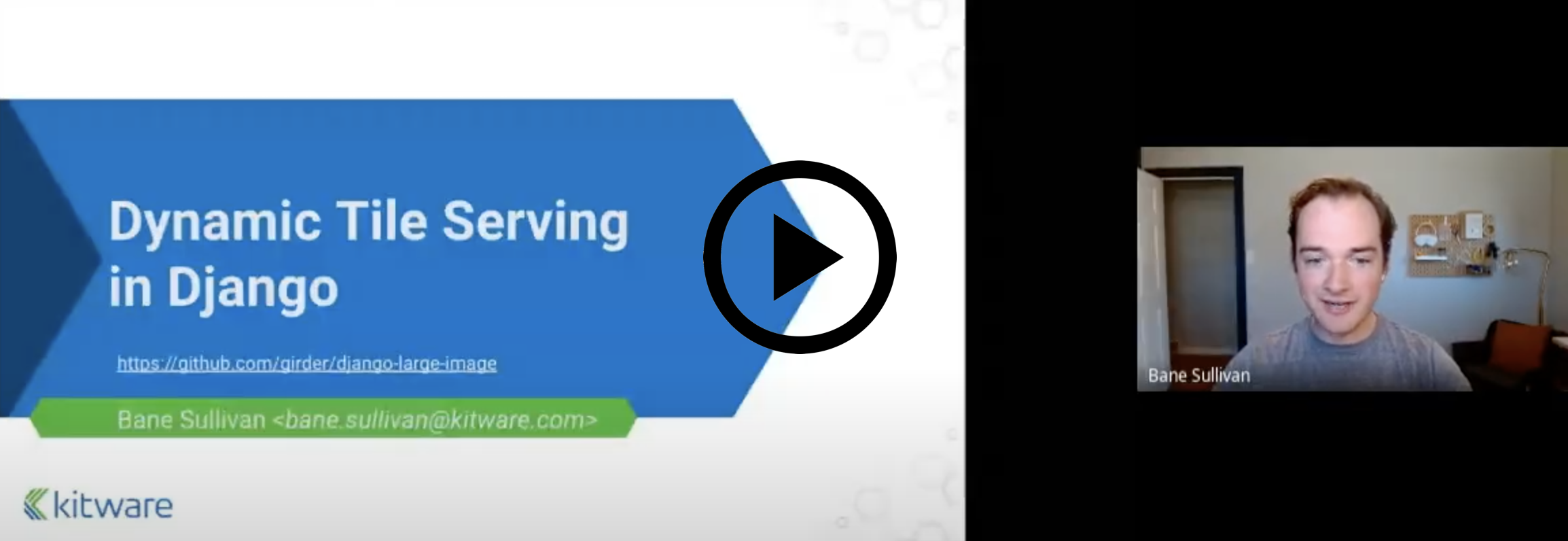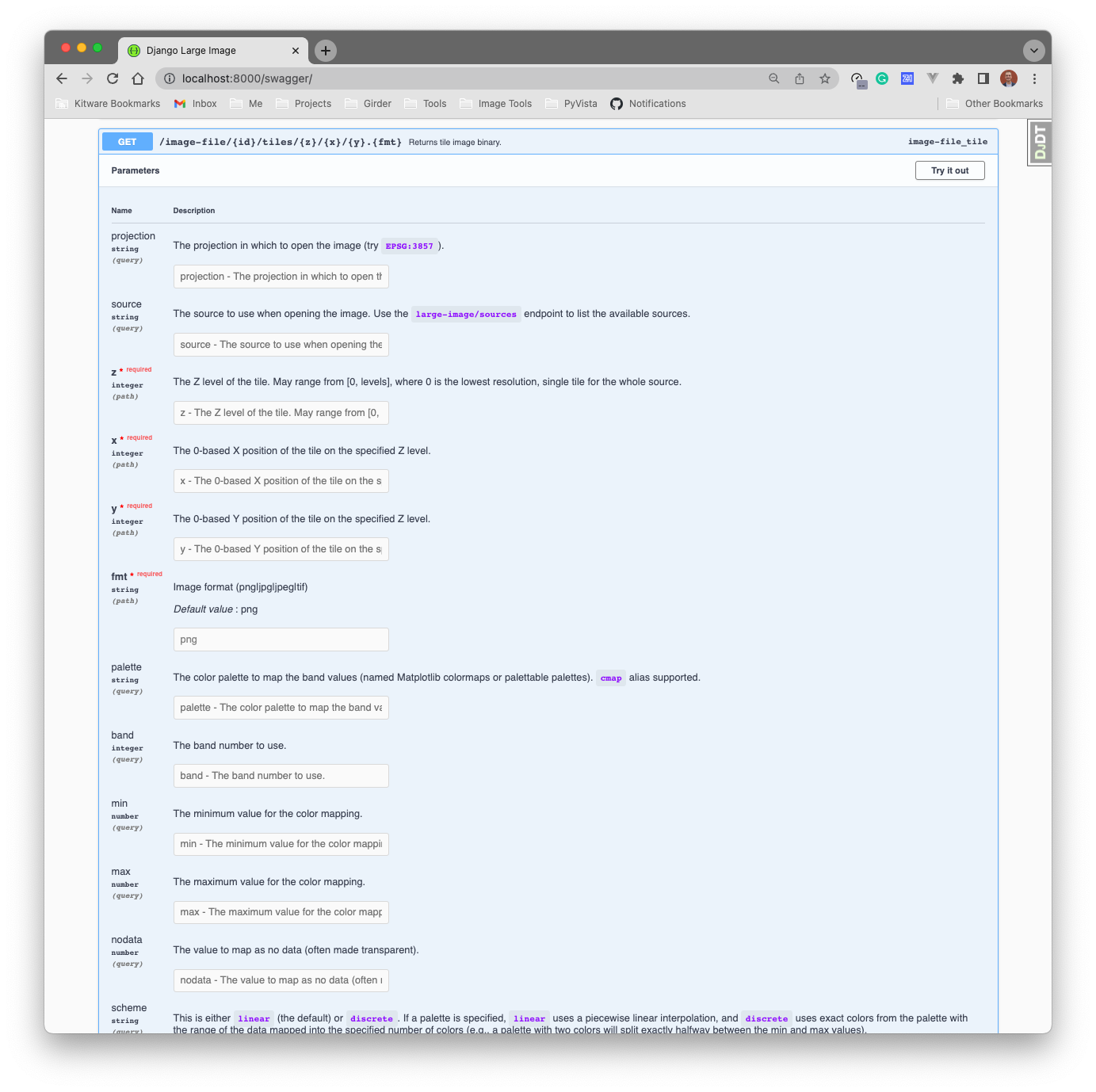🩻 🗺️ django-large-image
django-large-image is an abstraction of large-image
for use with django-rest-framework providing viewset mixins for endpoints to
work with large images (Cloud Optimized GeoTiffs or medical image formats) in
Django. The dynamic tile server provided here prevents the need for
preprocessing large images into tile sets for viewing interactively on
slippy-maps. Under the hood, large-image applies operations (rescaling,
reprojection, image encoding) to create image tiles on-the-fly.
| Lightning Talk for 2022 Cloud-Native Geospatial Outreach Event |
|---|
 |
| View slides here |
Table of Contents
ℹ️ Overview
This package brings Kitware's large-image to Django by providing a set of abstract, mixin API viewset classes that will handle tile serving, fetching metadata from images, and extracting regions of interest.
django-large-image is an installable Django app with
a few classes that can be mixed into a Django project (or application)'s
drf-based viewsets to provide tile serving endpoints out of the box. Notably,
django-large-image is designed to work specifically with FileField
interfaces with development being tailored to Kitware's
S3FileField. GeoDjango's GDALRaster
can also be used by returning GDALRaster.name in the get_path() override.
This package ships with pre-made HTML templates for rendering geospatial image tiles with CesiumJS and non-geospatial image tiles with GeoJS.

Dynamic tile server in Django built on top of large-image (and GDAL)
🤝 Support
django-large-image and the supporting large-image
library are developed and maintained by the Data & Analytics group at
Kitware, Inc.
We work with large image data in both the geospatial and medical capacities.
If you have questions about these technologies, or you would like to discuss
your own geospatial and medical image problems and learn how we can help,
please reach out at kitware@kitware.com. We look forward to the conversation!
🌟 Features
Rich set of RESTful endpoints to extract information from large image formats:
- Image metadata (
/info/metadata,/info/metadata_internal) - Tile serving (
/tiles/{z}/{x}/{y}.png?projection=EPSG:3857) - Region extraction (
/data/region.tif?left=v&right=v&top=v&bottom=v) - Image thumbnails (
/data/thumbnail.png) - Individual pixels (
/data/pixel?left=v&top=v) - Band histograms (
/data/histogram)
Support for any storage backend:
- Supports Django's
FileField - Supports
S3FileField - Customizable method for handling data access (
get_pathoverride) - Supports GDAL's Virtual File System for
s3://,ftp://, etc. URLs
Miscellaneous:
- Admin interface widget for viewing image tiles.
- Caching
- image tiles and thumbnails are cached to prevent recreating these data on multiple requests
- utilizes the Django cache framework. Specify a named cache to use with the
LARGE_IMAGE_CACHE_NAMEsetting.
- Easily extensible SSR templates for tile viewing with CesiumJS and GeoJS
- OpenAPI specification
| OpenAPI Documentation | Tiles Endpoint |
|---|---|
 |
 |
⬇️ Installation
Out of the box, django-large-image only depends on the core large-image
module, but you will need a large-image-source-* module in order for this
to work. Most of our users probably want to work with geospatial images so we
will focus on the large-image-source-gdal and `large-image-source-rasterio
cases, but it is worth noting that large-image has source modules for a wide
variety of image formats (e.g., medical image formats for microscopy).
See large-image's
installation instructions for more details.
🎡 pip
Rasterio
pip install \
django-large-image \
'large-image[rasterio,pil]>=1.22'GDAL
*Tip: installing GDAL is notoriously difficult, so at Kitware we provide
pre-built Python wheels with the GDAL binary bundled for easily installation in
production linux environments. To install our GDAL wheel, use:
pip install --find-links https://girder.github.io/large_image_wheels GDAL*
pip install \
--find-links https://girder.github.io/large_image_wheels \
django-large-image \
'large-image[gdal,pil]>=1.16.2'🐍 Conda
Or install with conda:
conda install -c conda-forge django-large-image large-image-source-rasterioconda install -c conda-forge django-large-image large-image-source-gdal🚀 Usage
Simply install the app and mixin one of the mixing classes to your
existing django-rest-framework viewset.
# settings.py
INSTALLED_APPS = [
...,
'django_large_image',
]The following are the provided mixin classes and their use case:
LargeImageMixin: for use with a standard, non-detailViewSet. Users must implementget_path()LargeImageDetailMixin: for use with a detail viewset likeGenericViewSet. Users must implementget_path()LargeImageFileDetailMixin: (most commonly used) for use with a detail viewset likeGenericViewSetwhere the associated model has aFileFieldstoring the image data.LargeImageVSIFileDetailMixin: (geospatial) for use with a detail viewset likeGenericViewSetwhere the associated model has aFileFieldstoring the image data that is intended to be read with GDAL/rasterio. This will access the data over GDAL's Virtual File System interface (a VSI path).
Most users will want to use LargeImageFileDetailMixin and so the following
example demonstrate how to use it:
Specify the FILE_FIELD_NAME as the string name of the FileField in which
your image data are saved on the associated model.
# viewsets.py
from rest_framework import viewsets
from django_large_image.rest import LargeImageFileDetailMixin
class MyModelViewSet(viewsets.GenericViewSet, LargeImageFileDetailMixin):
... # configuration for your model's viewset
FILE_FIELD_NAME = 'field_name'# urls.py
from django.urls import include, path
from rest_framework.routers import SimpleRouter
from myapp.viewsets import MyModelViewSet
router = SimpleRouter(trailing_slash=False)
router.register(r'api/my-model', MyModelViewSet)
urlpatterns = [
# Additional, standalone URLs from django-large-image
path('', include('django_large_image.urls')),
] + router.urlsAnd that's it!
📝 Example Code
To use the mixin classes provided here, add django_large_image to the
INSTALLED_APPS of your Django project, then create a model, serializer,
and viewset in your Django project like so:
# models.py
from django.db import models
from rest_framework import serializers
class ImageFile(models.Model):
name = models.TextField()
file = models.FileField()
class ImageFileSerializer(serializers.ModelSerializer):
class Meta:
model = ImageFile
fields = '__all__'# admin.py
from django.contrib import admin
from example.core.models import ImageFile
@admin.register(ImageFile)
class ImageFileAdmin(admin.ModelAdmin):
list_display = ('pk', 'name')Then create the viewset, mixing in the django-large-image viewset class:
# viewsets.py
from example.core import models
from rest_framework import mixins, viewsets
from django_large_image.rest import LargeImageFileDetailMixin
class ImageFileDetailViewSet(
mixins.ListModelMixin,
viewsets.GenericViewSet,
LargeImageFileDetailMixin,
):
queryset = models.ImageFile.objects.all()
serializer_class = models.ImageFileSerializer
# for `django-large-image`: the name of the image FileField on your model
FILE_FIELD_NAME = 'file'Then register the URLs:
# urls.py
from django.urls import include, path
from example.core.viewsets import ImageFileDetailViewSet
from rest_framework.routers import SimpleRouter
router = SimpleRouter(trailing_slash=False)
router.register(r'api/image-file', ImageFileDetailViewSet)
urlpatterns = [
# Additional, standalone URLs from django-large-image
path('', include('django_large_image.urls')),
] + router.urls(Optional) You can also use an admin widget for your model:
<!-- templates/admin/myapp/imagefile/change_form.html -->
{% extends "admin/change_form.html" %}
{% block after_field_sets %}
<script>
var baseEndpoint = 'api/image-file';
</script>
{% include 'admin/django_large_image/_include/geojs.html' %}
{% endblock %}Please note the example Django project in the project/ directory of this
repository that shows how to use django-large-image in a girder-4 project.
🛠️ Customization
The mixin classes are modularly designed and able to be subclassed
for your project's needs. While the provided LargeImageFileDetailMixin handles
FileField-interfaces, you can easily extend its base class,
LargeImageDetailMixin, to handle any mechanism of data storage in your
detail-oriented viewset.
In the following example, we demonstrate how to use GDAL compatible VSI paths
from a model that stores s3:// or https:// URLs.
# models.py
from django.db import models
from rest_framework import serializers
class URLImageFile(models.Model):
name = models.TextField()
url = models.TextField()
class URLImageFileSerializer(serializers.ModelSerializer):
class Meta:
model = URLImageFile
fields = '__all__'# admin.py
from django.contrib import admin
from example.core.models import URLImageFile
@admin.register(URLImageFile)
class URLImageFileAdmin(admin.ModelAdmin):
list_display = ('pk', 'name')# viewsets.py
from example.core import models
from rest_framework import mixins, viewsets
from django_large_image.rest import LargeImageDetailMixin
from django_large_image.utilities import make_vsi
class URLLargeImageMixin(LargeImageDetailMixin):
def get_path(self, request, pk=None):
object = self.get_object()
return make_vsi(object.url)
class URLImageFileDetailViewSet(
mixins.ListModelMixin,
viewsets.GenericViewSet,
URLLargeImageMixin,
):
queryset = models.URLImageFile.objects.all()
serializer_class = models.URLImageFileSerializerHere is a good test image: https://oin-hotosm.s3.amazonaws.com/59c66c5223c8440011d7b1e4/0/7ad397c0-bba2-4f98-a08a-931ec3a6e943.tif
🥸 Non-Detail ViewSets
The LargeImageMixin provides a mixin interface for non-detail viewsets (no
associated model or primary key required). This can be particularly useful if
your viewset has custom logic to retrieve the desired data.
For example, you may want a viewset that gets the data path as a URL embedded
in the request's query parameters. To do this, you can make a standard ViewSet
with the LargeImageMixin like so:
# viewsets.py
from rest_framework import viewsets
from rest_framework.exceptions import ValidationError
from django_large_image.rest import LargeImageMixin
from django_large_image.utilities import make_vsi
class URLLargeImageViewSet(viewsets.ViewSet, LargeImageMixin):
def get_path(self, request, pk=None):
try:
url = request.query_params.get('url')
except KeyError:
raise ValidationError('url must be defined as a query parameter.')
return make_vsi(url)
🪄 Styling
django-large-image's dynamic tile serving supports band styling and making
composite images from multiple frames and/or bands of your images. This means
that you can easily create a false color image from multispectral imagery.
django-large-image has two styling modes:
- A simple interface to colormap a single channel using multiple query parameters. These are the documented OpenAPI query parameters.
View a single band with a Matplotlib colormap:
var thumbnailUrl = `http://localhost:8000/api/image-file/${imageId}/data/thumbnail.png?band=3&palette=viridis&min=50&max=250`;- A complex specification for styling across frames and bands to create composite images using a JSON specification defined by
large-image.
Create a false color image from multiple bands in the source image:
// See https://girder.github.io/large_image/tilesource_options.html#style
var style = {
bands: [
{band: 5, palette: ['#000', '#f00']}, // red
{band: 3, palette: ['#000', '#0f0']}, // green
{band: 2, palette: ['#000', '#00f']} // blue
]
};
var styleEncoded = encodeURIComponent(JSON.stringify(style))
var thumbnailUrl = `http://localhost:8000/api/image-file/${imageId}/data/thumbnail.png?style=${styleEncoded}`;☁️ Converting Images to Pyramidal Tiffs (COGs)
Install large_image_converter and run the following:
import large_image_converter
large_image_converter.convert(input_path, output_path)It's that easy! The default parameters for that function will convert geospatial rasters to Cloud Optimized GeoTiffs (COGs) and non-geospatial images to a pyramidal tiff format.
It's quite common to have a celery task that converts an image from a model in your application. Here is a starting point:
import os
from example.core import models
from celery import shared_task
import large_image_converter # requires large-image-source-gdal
@shared_task
def task_convert_cog(my_model_pk):
image_file = models.ImageFile.objects.get(pk=my_model_pk)
input_path = image_file.file.name # TODO: get full path to file on disk
with tempfile.TemporaryDirectory() as tmpdir:
output_path = os.path.join(tmpdir, 'converted.tiff')
large_image_converter.convert(input_path, output_path)
# Do something with converted tiff file at `output_path`
...If using the rasterio-based source module, we recommend using
rio-cogeo
over large_image_converter.
Using with django-raster
django-raster is a popular
choice for storing geospatial raster data in Django. django-large-image works
well with django-raster to provide additional endpoints for dynamic tile
serving and more.
Please take a look at the demo project here: https://github.com/ResonantGeoData/django-raster-demo
and raise any questions about usage with django-raster there.
Demo App
There is a vanilla Django project in the demo/ directory and this app
is published as a standalone Docker image that anyone can try out:
docker run -it -p 8000:8000 -v dli_demo_data:/opt/django-project/data ghcr.io/girder/django-large-image-demo:latest

